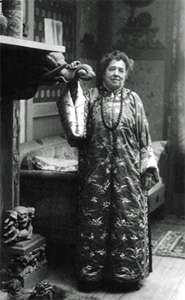Emily Noyes Vanderpoel
Emily Noyes Vanderpoel (June 21, 1842 – February 20, 1939) was an American artist, writer, and philanthropist.
Emily Noyes Vanderpoel | |
|---|---|
 | |
| Born | Emily Caroline Noyes June 21, 1842 New York City |
| Died | February 20, 1939 (aged 96) |
| Nationality | American |
| Known for | Painting, writer, historian |
| Spouse(s) | John Aaron Vanderpoel ( m. 1865) |
Early life
Emily Caroline Noyes was born on June 21, 1842 in New York City to William Curtis Noyes and Julia Tallmadge Noyes.[1] She was the great-granddaughter of Col. Benjamin Tallmadge.[2] She was educated in private schools in New York, and later studied art under Robert Swain Gifford and William Sartain.[1]
On May 22, 1865, she married John Aaron Vanderpoel, with whom she had one son, John Arent Vanderpoel. They lived in New York City and Litchfield, Connecticut. After a year her husband died before she gave birth. She remained unmarried.[3]
Career
_from_a_mummy_case.jpg)
_LVII_mummy_cloth.jpg)
Emily Noyes Vanderpoel was known for her work as a painter, working in watercolors and oils.[4] She was a member of the New York Watercolor Club (of which she also served a term as Vice-President) and the Woman's Art Club of New York.[5] She exhibited her work at the Woman's Building at the 1893 World's Columbian Exposition in Chicago, Illinois.[6] There she was awarded a bronze medal.[5]
Beyond her artistic career, Noyes Vanderpoel was also a philanthropist and an active participant in the Litchfield community. She was the Honorary President of the Needle and Bobbin Club of Litchfield, and the Vice-President and Curator of the Litchfield Historical Society, during which time she published a two-volume history of the Litchfield Female Academy. She was also a member of the Daughters of the American Revolution.[7]
She was the author of the Color Problems, which was published in 1902. The book had 400 pages and 116 colour illustrations. Vanderpoel would create a ten by ten grid and then record the colours used in a cup and saucer, an Egyptian mummy. Vanderpoel recommended F.W,Moody's idea that nature's palettes were nearly always a good match. She suggested that a marquetry cabinet that was designed with the same colours as a dead sparrow would be "balanced".[3] It has been suggested that her theories anticipate later theories but Vanderpoet was not attributed. Her book was brought back into print in 2018.[3]
She died on February 20, 1939, and is buried in East Cemetery in Litchfield.[7]
Legacy
Vanderpoel donated her art pottery collection to the Litchfield Historical Society and her Japanese art collection to the Norwich Museum.[6]
Works
- Color problems: a practical manual for the lay student of color (1902)
- Chronicles of a pioneer school from 1792 to 1833 (1903)
- The tale of the spinning wheel (1903) (illustrator)
- American Lace and Lace-Makers (1924)
- More chronicles of a pioneer school, from 1792 to 1833 (1927)
References
- "Emily Noyes Vanderpoel". The Ledger: A Database of Students of the Litchfield Law School and the Litchfield Female Academy. Litchfield Historical Society. Retrieved March 21, 2016.
- Litchfield Historical Society (1920). The history of the town of Litchfield, Connecticut, 1720–1920. p. 111. Retrieved April 9, 2016.
- Lasky, Julie (October 4, 2018). "New Life for a 1902 Manual About Color". The New York Times. Retrieved January 19, 2019.
- The artists year book. Art League Publishing Association. 1905. p. 205. Retrieved April 15, 2016.
- "Directory of painters, sculptors, illustrators". American Art Annual. 6: 428. 1908. Retrieved April 15, 2016.
- Nichols, K. L. "Women's Art at the World's Columbian Fair & Exposition, Chicago 1893". Retrieved January 18, 2019.
- "Vanderpoel, Emily Noyes (1842–1939)". Litchfield Historical Society. Retrieved April 15, 2016.
External links
![]()